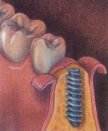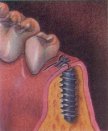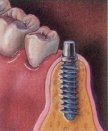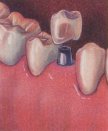Why Replace Teeth?
|
| Plaque builds up more easily
as the teeth crowd together or shift, increasing the risk of decay and gum disease.
|
 |
| When teeth shift so that the upper teeth no
longer mesh with the lower ones, chewing can be impaired and can create stress on other teeth and the jaw.
|
 |
|

If back teeth are lost, adjacent teeth can shift into
vacant spaces. Shifting can also cause the cheeks to sink in and the face to change appearance. The lips may thin and straighten,
the chin may just out and upward, and pouches may appear on the sides of the jaw. |
|
|
| Implants |
What are they: Implants--artificial tooth supports
surgically set in the jaw--are used in combination with bridges, dentures, and crowns to replace any number of missing teeth.
Who is a candidate: Adults who have healthy gums, adequate bone to support the implant, and a commitment
to meticulous oral hygiene.
Visits: Implants require one or two outpatient or office surgeries and take from three to nine months to
complete. Monthly checkups are usually recommended between surgeries.
|
|
| How Implants Are Used |
 |
To replace a single tooth with a crown |
|
 |
To replace multiple teeth with a bridge |
|
 |
To replace all upper or lower teeth with dentures |
|
|
Types of Implants
 |
 |
 |
Root form or cylinder
(placed in bone) |
Blade or plate
(placed in bone) |
Subperiosteal
(placed on top of jawbone) |
|
How Implants Are Placed
 |
 |
 |
 |
 |
| An incision is made at the implant site. |
After the site is prepared, the fixture is
screwed or pressed into place in the jawbone. |
The site is covered for three to six months to
allow the bone to grow around the implant. |
The top of the fixture is then exposed and an
abutment is attached. (Sometimes abutments and fixtures can be placed in one visit.) |
A bridge, crown (shown),
or denture is attached. |
|
|



